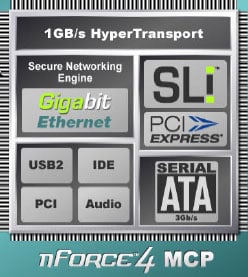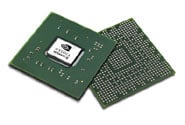NVIDIA nForce4 Chipset Preview
Introduction and Specifications
 NVIDIA's ride as a chipset designer and manufacturer has been tumultuous in spots without question. The first two iterations of its nForce product family were immensely popular because they addressed weaknesses that plagued other chipsets, such as memory and integrated graphics performance. However, they are correspondingly more expensive than other chipsets and motherboards that centered on both nForce and nForce2 suffered repeated delays.
NVIDIA's ride as a chipset designer and manufacturer has been tumultuous in spots without question. The first two iterations of its nForce product family were immensely popular because they addressed weaknesses that plagued other chipsets, such as memory and integrated graphics performance. However, they are correspondingly more expensive than other chipsets and motherboards that centered on both nForce and nForce2 suffered repeated delays.
As AMD transitioned to its eighth-generation processor architecture with an integrated memory controller, NVIDIA lost the one advantage that really differentiated its products with regard to performance. It subsequently dropped some of the other desktop-oriented features, such as integrated graphics and the advanced SoundStorm audio processing unit. AMD unveiled the server- and workstation-oriented Opteron before the Athlon 64 that we know today, and NVIDIA was immediately on board with a comparable chipset that was all work and no play.
Several months later, when the Athlon 64 FX and Athlon 64 processors hit the scene, NVIDIA was still touting the benefits of its nForce3 150 and VIA swooped on the enthusiast market that was eager for a feature-rich motherboard to accompany AMD's Athlon 64. NVIDIA took a step in the right direction by updating its lineup with the nForce3 Ultra, but VIA had already established solid momentum with the K8T800-series. Despite some notable architectural advantages, the two chipsets seem to be equally popular amongst those looking for new platforms.
NVIDIA is determined to earn back the favor of enthusiasts with an entirely new family of chipsets called the nForce4. And they're not just regurgitations of old hardware either. No, these are the first products to support PCI Express' serial link topology, instead of the aging PCI bus, amongst a host of other advancements.
|
| Support for the latest AMD Opteron, Athlon 64, and Sempron Processors 20 Lanes of PCI Express Connectivity ·_nForce4 SLI features 20 configurable lanes ·_nForce4 and nForce4 Ultra feature 20 fixed lanes ( one x16 and three x1 lanes( Asynchronous Bus Architecture ·_AGP/PCI Lock allows easier tweaking of the CP 1 GHz HyperTransport Technology Link ·_1GHz HyperTransport link that is 16-bits wide to offer 8 GBps of peak throughput Expansive Storage Features ·_Support for SATA 3 Gbps ·_Four SATA ports and two PATA ports (each of which supports two drives) ·_Twin SATA controllers for improved performance with multiple drives ·_Support for RAID 0, 1, and 0+1 ·_Support for RAID Morphing ·_RAID supported across SATA and PATA controllers |
Networking and Security ·_nForce4 SLI and nForce4 Ultra feature Secure Networking Engine ·_Native Gigabit Ethernet ·_NVIDIA Firewall 2.0 nTune Performance Utility ·_Automatic performance tuning ·_Safe state recovery ·_GPU Overclocking
|

NVIDIA is certainly no stranger to single-chip designs and it has once again managed to cram all of its core logic into one package. Of course, that means that there still aren't any variations with integrated graphics and audio enthusiasts will continue missing SoundStorm. NVIDIA did focus on a couple of other pertinent technologies, including optimized networking, storage, and graphics components. If you're adamant about high-quality audio, you'll have to spring for an add-in card. And most enthusiasts didn't care much for the nForce2's integrated GeForce4 MX core anyway, right?
Beyond a complex networking engine, advanced storage subsystem, and specialized graphics implementation, all three models of the nForce4 chipset feature 10 USB 2.0 ports, a handful of standard PCI ports, AC'97 audio, and 20 lanes of PCI Express connectivity.







